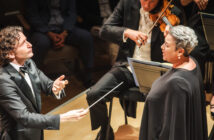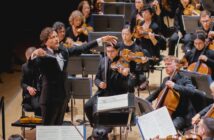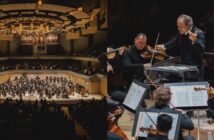
Place des Arts
Montréal, Quebec
September 29, 2011
Hasn’t the Orchestre symphonique de Montréal (OSM) always been a great French orchestra? In the halcyon days of Charles Dutoit, conductor and orchestra became Decca’s house orchestra for French music the way Ernest Ansermet and L’Orchestre de la Suisse Romande had been for the same label a generation earlier. Dutoit is no longer in Montreal, but the orchestra’s reputation for French music lives on; one hardly needs a senior French conductor like 78-year old Michel Plasson to “teach” the OSM about French music. Rather like bringing coals to Newcastle, isn’t it? And yet, this week in Montreal, Plasson did bring something special to this all-French programme and the audience loved it.
A Nugget of Gold from Gounod
I must confess that I warm instantly to any conductor who programs either of Gounod’s symphonies, beautiful and joyous pieces, rarely performed. I much prefer either one of them to Bizet’s vastly overplayed Symphony in C major from the same period. In fact, Gounod was Bizet’s teacher and Bizet very likely modeled his symphony on that of his mentor.
While one generally thinks of Gounod in terms of Grand Opera, his compositions do include some symphonies modeled after those of Haydn and early Beethoven. Apparently, he wasn’t much influenced by the contributions of Berlioz to French music; there isn’t much drama or angst in Gounod’s symphonies – not much originality either. There are, however, plenty of perky tunes and playful rhythms. Plasson’s reading of Symphony No. 1 would have benefitted from more energy and bravado – surely the trumpet fanfares in the last movement require more assertiveness than Plasson allowed – but happily, the music was well played.
Compelling Collaboration with Capuçon
Cellist Gautier Capuçon has been steadily building his reputation in Europe and recently scored a huge triumph when he performed with his brother Renaud (violin) and Gustavo Dudamel (conductor) in a concert broadcast to theatres around the world. With Plasson and the OSM, Capuçon gave a superb account of Saint-Saens’ Cello Concerto No. 1. His technique is beyond reproach and his tone full and pleasing in every register. The piece is cleverly scored to allow the cello to be heard at its softest, and Plasson went a step further in getting the OSM musicians to follow suit as required.
Perplexing Ravel and Repressed Roussel
After intermission the orchestra practically doubled in size for the Ravel and Roussel. Ravel’s Valses nobles et sentimentales is a strange work that usually leaves audiences perplexed. Most of the waltzes are so slow as to be unrecognizable as waltzes and the last section is melancholy to the point of depression. There is nothing in this composition approaching the colour and excitement of Ravel’s more famous waltz piece,La Valse. On its own terms, however, Valses nobles et sentimentales is a marvel of intricate harmonic and timbral invention and Plasson and the OSM gave it its due.
Albert Roussel (1869-1937) has always been a maverick in Twentieth Century French music. As impressionistic as Debussy, he too was fascinated by the music and culture of other countries. He was also a classicist, writing four symphonies while Debussy and Ravel wrote none. His ballet score Bacchus et Ariane recalls the driving rhythms of Le sacre du printemps and the sensuality of Bartok’s Miraculous Mandarin.
The Suite No. 2 from Bacchus et ariane is probably Roussel’s most frequently played piece today and audiences generally respond positively to its colour and excitement. It is also hauntingly beautiful – the viola and violin solos in the opening bars against a meandering bassoon line are wonderfully eloquent – and hints at something dangerous in its Dionysian fervour. Plasson and the OSM played this music very well indeed but I came away with the impression that Plasson doesn’t really do ‘Dionysian.’ Gallic charm and old world elegance are not enough here. The music surely requires more intensity – full-throated brass and pounding percussion – in the final section .
Exquisite Encore a Rare Treat
Plasson won me back by ending the concert with an encore. Neeme Järvi used to do encores in Detroit, but I am not aware of any other conductor doing them. For his encore on this occasion, Plasson chose the Adagietto from Bizet’s L’Arlésienne and while it is a quiet piece, I have never heard it played as softly as it was on this night. What exquisite music and played with love and sensitivity! These “encore” pieces are rarely played at serious concerts anymore although one may run across them at Pops concerts. And what a great way to send an audience out into the night, with gems such as these ringing in their ears and warming their hearts. Vive Michel Plasson!
Clear and Present Sound but…
For the record, this was my second visit to the OSM’s new hall and this time I sat in the third row of the Corbeille, or First Balcony. The sound was much warmer here than it was from my last seat in the Balcon or top Balcony. The quiet passages – of which there were many in this concert – sounded just right. I expected a better test of the loud passages than Plasson gave us, but once again everything was clear and had presence. So far, I am not impressed with the bass response; I don’t hear that characteristic buzz on the low notes of the double basses nor does the sound of the bass drum have much depth. It is early yet and there is fine tuning to be done by the orchestra and the technicians.
Open Lobby Looking Good!
Regarding the lobby areas in the hall, I must note that I was very favorably impressed by the Parterre level space. Last time, much of this space was curtained off for VIP receptions. On this night, the lobby seemed much more spacious and the coloured lighting with furniture to match was very effective. In good weather, once the exteriors are finished, it will be possible to stroll on an outdoor terrace opening off the Parterre level at intermission.
Paul E. Robinson is the author of Herbert von Karajan: the Maestro as Superstar, and Sir Georg Solti: His Life and Music. For friends: The Art of the Conductor podcast, “Classical Airs.”
Photo by: Marita














